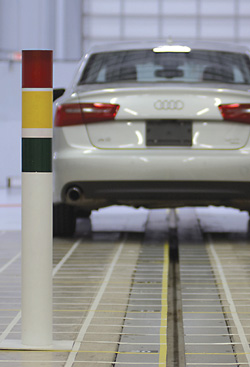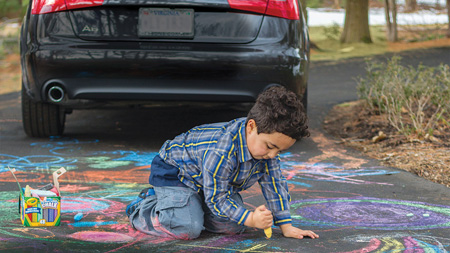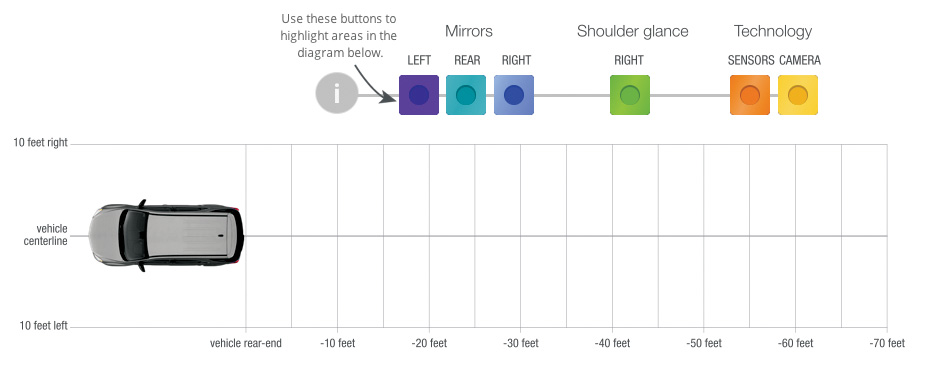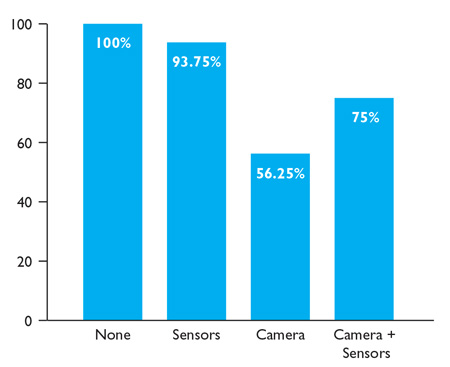|
||||
PREVENTING DRIVEWAY TRAGEDIES: REAR CAMERAS HELP DRIVERS SEE BEHIND THEMRear cameras are more effective than parking sensors at helping drivers avoid objects while traveling in reverse, but they don't help in every situation, a new IIHS study shows. The study, conducted with volunteer drivers in an empty parking lot in the Los Angeles area, indicates that cameras would help prevent more backover crashes into pedestrians in the vehicle's blind zone than parking sensors. Surprisingly, cameras by themselves worked better than sensors and cameras combined. |
|
Rear visibility in a typical SUV: 2013 Chevrolet Equinox LTZ
|
How drivers use technology
The study with volunteer drivers built on this work by allowing researchers to see how drivers use the technologies and whether they prevent crashes.
The analysis was based on the experience of 111 volunteers using a 2013 Chevrolet Equinox LTZ. The Equinox was chosen because it was a high volume midsize SUV, and in the earlier visibility measurements it had neither the smallest nor the largest blind zone.
The purpose of the study was disguised from the volunteers who were told they were there to evaluate the SUV's entertainment and information systems. After completing some parking maneuvers and tasks such as tuning the radio and reading from a navigation display, they were then told to back out of a spot and return to where they had left their personal vehicles. As they backed out, a foam cutout of a child size crash test dummy was put in the vehicle's backing path.
In some cases, the foam dummy was stationary behind the vehicle, while in other cases it moved into the vehicle's path from the driver's side. Few of the volunteer drivers hit the object if it was moving, and neither the backup camera nor the parking sensors provided a statistically significant benefit in those cases. The proportion of drivers who collided with the stationary object was 4 times as large as the proportion that collided with the moving object.
Drivers with the rearview camera alone had the fewest collisions with the stationary object; 56 percent of them hit it. In contrast, all the drivers who had no technology hit the stationary object, while parking sensors alone helped just 1 out of 16 drivers avoid a crash.
For drivers who had both the camera and the sensors, the benefit wasn't as great as with the camera alone. Three-quarters of these drivers hit the stationary object.
It may be that the sensors, which detect objects up to 8 feet behind the vehicle at speeds less than 5 mph, gave drivers a false sense of security so they paid less attention to the camera display.
Slightly fewer drivers who had both cameras and sensors looked at the camera display at least once than drivers who had only cameras, and they spent a smaller proportion of time looking at the camera display while backing, but these differences weren't statistically significant.
"The sensors might be more useful if they had a larger range and could provide an earlier warning," says David Kidd, an IIHS research scientist and the lead author of both studies. "Even when drivers braked in response to the sensor few
collisions were prevented."
Rearview cameras didn't prevent all collisions, even when properly used. When the stationary object was in the shade, for example, nearly every driver who looked at the display still hit it. In the real world, weather and lighting conditions would likely affect the usefulness of cameras. These issues may help explain why HLDI didn't find consistent reductions in insurance claims when it studied camera systems offered by Mazda and Mercedes-Benz (see Status Reportspecial issue: crash avoidance, July 3, 2012).
The research into backing technologies comes as the National Highway Traffic Safety Administration (NHTSA) is considering whether to require cameras on passenger
vehicles. Congress directed the agency in 2008 to expand the required field of view behind a vehicle.
NHTSA hasn't yet finalized the regulation but previously indicated that cameras are the only technology available that could meet the congressional mandate. The agency announced in September 2013 that it would be adding rearview cameras to the list of recommended features in its vehicle safety ratings.
In comments to NHTSA, the Institute has said it supports efforts to encourage rearview cameras. At the same time, it has urged the agency to require that a certain minimum amount of space around a vehicle be directly visible using backward glances and mirrors.
"Having an available rearview video system on a vehicle model should not justify design choices that restrict direct visibility around the vehicle," the Institute wrote in a July comment.
Manufacturers also may be able to improve the technological options. Both cameras and sensors likely would be more effective if they were combined with automatic rear braking technology. Autobrake for front crash prevention has been found to be more effective at preventing or mitigating frontal crashes than warning systems alone.
 |
Study 1: Measuring visibility Researchers measured the visibility of children to an average size male driver in 21 vehicles, using mirrors, an over the shoulder glance and technology. A pole painted with three bands representing the average heights of a 12-15 month-old, a 2½-3 year-old and a 5-6 year-old was placed at various spots behind each vehicle to determine where each of the bands could be seen by the driver. |
Study 2: How drivers use technology
Volunteers drove a 2013 Chevrolet Equinox LTZ. Some drivers had access to the rear camera, others had the parking sensors, and some had both. The rest had neither technology. Before they backed out a foam cutout of a child was put in their path.




